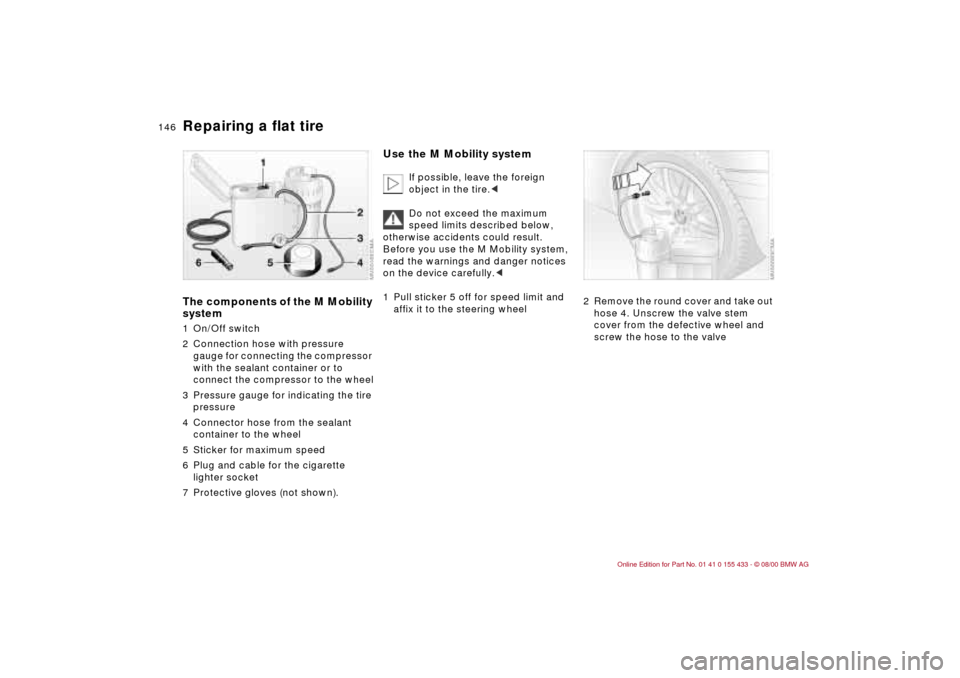2001 BMW M3 COUPE steering wheel
[x] Cancel search: steering wheelPage 109 of 183

109n
IndexDataTechnologyRepairsCar careControlsOverview
Winter operationBrakingWinter road conditions substantially
reduce the amount of traction available
between the tires and the road surface;
the resulting increase in braking
distance is considerable and should
always be kept in mind.
ABS is intended to prevent the wheels
from locking during brake applications,
thus helping to maintain vehicle stability
and steering response.
If the ABS does not respond in a critical
braking situation and the wheels lock:
Reduce the pressure on the brake
pedal until the wheels just start to roll
again while still maintaining enough
force to continue braking. Then
increase the pressure, reduce the pres-
sure when the wheels lock, reapply
pressure etc.
This staggered braking procedure will
reduce stopping distances while
helping you maintain steering control.
You can then attempt to steer around
hazards after you have reduced pres-
sure on the brake pedal. Do not shift down on slick road
surfaces. Doing so could cause
the rear wheels to lose traction and
skid, which could result in the loss of
vehicle control.<
Depress the clutch during hard
braking on road surfaces which
provide only poor or uneven traction.<
Skid control Depress the clutch and let up on the
gas. Countersteer carefully and attempt
to regain control of the vehicle.
ParkingEngage first or reverse gear. Depending
on the steepness of the incline, you can
apply the parking brake as well. In order
to prevent the parking brake pads from
locking due to frost or corrosion, dry
them by gently applying the parking
brake as the vehicle is coming to a
stop. Make sure that following traffic
is not endangered.
The brake lamps do not light up
when the parking brake is
applied.<
Page 115 of 183

115n
IndexDataTechnologyRepairsCar careControlsOverview
Winter tires Snow chainsChoosing the right tire BMW recommends winter tires (M+S
radial tires) for operation under inclem-
ent winter driving conditions. While
so-called all season tires (M+S desig-
nation) provide better winter traction
than summer tires with the load ratings
H, V, W, Y and ZR, they generally do
not achieve the performance of winter
tires.
In the interests of safe tracking and
steering response, install radial tires
made by the same manufacturer and
with the same tread configuration on all
four wheels if you elect to mount winter
tires. Do not exceed specified
maximum speedsIn Germany: attach a corresponding
sign in accordance with the Federal
Motor Vehicles Safety Standards in
your field of vision if the maximum
speed of the vehicle is higher. This
sticker is available from the tire dealer
or your BMW center. Never exceed the maximum speed
for which the tires are rated.
Unprofessional attempts by laymen to
service tires can lead to damage and
accidents.
Have this work performed by skilled
professionals only. Your BMW center
will be glad to assist you with both their
expertise and the proper equipment for
your vehicle.<
Tire condition, tire pressureWinter tires display a perceptible loss in
their ability to cope with winter driving
conditions once the tread wears to
below 0.16 in (4 mm), and should thus
be replaced.
Comply with the specified tire inflation
pressure and be sure to have the
wheels balanced each time a tire or
wheel is changed. In addition, also have
the Tire Pressure Warning (RDW) reini-
tialized, for details refer to page 78.
The use of narrow-link BMW snow
chains on winter tires is approved only
in pairs and only on the rear wheels.
Comply with all manufacturer's safety
precautions when mounting the chains.
Deactivate the Tire Pressure
Warning (RDW) when using snow
chains. The snow chains can lead to
malfunction warnings and undetected
losses in pressure.
For further information, refer to
page 78.<
Page 133 of 183

133n
IndexDataTechnologyRepairsCar careControlsOverview
Airbags Vehicle storageImportant safety notices
Don't remove the airbag restraint
system's gas generator. Have
testing and service procedures per-
formed by specially-qualified techni-
cians only. In the event of any faults, if
the airbag stops working, or in the
event of function-oriented use (deploy-
ment) of the airbag restraint system,
entrust your BMW center alone with
repair or disassembly.
No modifications may be made to either
the wiring or to individual components.
These include the padded steering
wheel hub, the instrument panel, the
side trim panels of the front or rear
doors and the roof pillars or the sides of
the headliner. Do not apply adhesive
materials to these components, cover
or modify them in any way. Do not
remove or dismantle the steering wheel
yourself.
To ensure compliance with official
safety regulations, entrust disposal of
airbag generators to a BMW center.
Unprofessional attempts to service the
system could lead to failure in an emer-
gency or undesired airbag activation,
either of which could result in personal
injury.<
Consult your BMW center regarding
special procedures if you intend to
store the vehicle for more than three
months.
Page 145 of 183

IndexDataTechnologyRepairsCar careControlsOverview
145n
Repairing a flat tire
Precautions in case of a flat tire:
Stop the vehicle as far as possible
from passing traffic; switch on the
hazard warning flashers.
Switch on the hazard warning flashers.
Turn the steering wheel to the straight-
ahead position, remove the key and
engage the steering lock. Shift into 1st
or reverse gear and engage the parking
brake.
All passengers should be outside the
vehicle and well away from your imme-
diate working area (behind a guardrail,
for instance).
If a warning triangle or portable hazard
warning lamp is available, set it up on
the roadside at an appropriate distance
from the rear of the vehicle.
Comply with all safety guidelines and
regulations.<
M Mobility system With the BMW M3, you will find an
M Mobility system for fixing flat tires.
With the aid of this system, you can
apply a liquid sealant to the inside of
the tire, thereby sealing off the
damaged area, and then continue
driving.
The M Mobility system makes trans-
porting a spare wheel superfluous,
thereby reducing the amount of weight
you have to carry around.
The M Mobility system is located in the
luggage compartment under the floor
panel:
1 Lift up the floor panel
2 Loosen the M Mobility system from
its storage location.
Note that the fluid bottle in the
system's sealant container must
be replaced every 3 years by your BMW
center if the system is not used.<
Page 146 of 183

146n
Repairing a flat tireThe components of the M Mobility
system1 On/Off switch
2 Connection hose with pressure
gauge for connecting the compressor
with the sealant container or to
connect the compressor to the wheel
3 Pressure gauge for indicating the tire
pressure
4 Connector hose from the sealant
container to the wheel
5 Sticker for maximum speed
6 Plug and cable for the cigarette
lighter socket
7 Protective gloves (not shown).
Use the M Mobility system
If possible, leave the foreign
object in the tire.<
Do not exceed the maximum
speed limits described below,
otherwise accidents could result.
Before you use the M Mobility system,
read the warnings and danger notices
on the device carefully.<
1 Pull sticker 5 off for speed limit and
affix it to the steering wheel
2 Remove the round cover and take out
hose 4. Unscrew the valve stem
cover from the defective wheel and
screw the hose to the valve
Page 159 of 183

159n
IndexDataTechnologyRepairsCar careControlsOverview
The limitations inherent to radio recep-
tion in a moving vehicle have been
minimized by a number of innovative
system designs:
The "Radio Data System" (RDS) makes
sure that, for broadcast stations
sending on several frequencies, the
radio automatically tunes to the
frequency with the best reception
quality.
The Diversity Antenna system employs
several FM antennas integrated within
the rear window to provide three sepa-
rate sources for receiving broadcast
waves. An integral processor automati-
cally selects the antenna with the best
FM reception quality at any given time.
The selection of the antenna takes
place within milliseconds, and is there-
fore not noticed by the radio listener. The primary goal in developing the
Dynamic Stability Control (DSC) for the
BMW M3 is to achieve the greatest
amount of safety while at the same time
getting the most pleasure out of perfor-
mance-oriented driving.
Using highly sensitive sensors, the DSC
monitors current operating conditions
for your vehicle as they relate to driving
stability and traction. In addition, wheel
speeds, steering angle, lateral acceler-
ation, brake pressure and vehicle
movement around its vertical axis are
also ascertained and evaluated.
If the DSC detects unstable conditions
on a curve, then the DSC will intervene
in engine management within millisec-
onds, reducing drive torque or, if the
need arises, will individually slow one or
more wheels down to keep the vehicle
on a steady course.
If differences in wheel speed should
occur, the system will recognize the
dangers associated with wheel spin
and will reduce the drive torque; if
necessary, it will do so using brake
intervention at the rear wheels as well.
DSC offers the highest degree of
driving stability and safety not only
when you first start your vehicle, are
driving on straightaways or when
braking, but also when driving through
curves.The safety belt tensioner makes sure
that the belt tightens during a head-on
collision to ensure that occupants
remain firmly positioned in their seats.
A gas-pressure system retracts the
buckle assembly to tension the
shoulder and lap belts within fractions
of a second. This reduces the tendency
to slide under the lap belt. Radio reception DSC Safety belt tensioner
Page 174 of 183

Everything from A to Z
A
ABS (Antilock Brake System) 21, 104
Accessories 6
Activated-charcoal filter 88
Add brake fluid 121t, 126 t
Adding engine oil 123t
Adding washer fluid 122t
Adjusting the backrest 46
Adjusting the lumbar support 48
Adjusting the seat 47
Adjusting the steering wheel 52
Adjusting the temperature 86
Adjusting the thigh support 47
Adjusting the width of the backrests 48
Air conditioner 87
Air distribution, automatic 86
Air nozzles 84
Air outlets 84
Air pressure, tires 26, 111
Air supply 87
vents, recirculated air
mode 87
Airbags 56, 133 , 158
warning lamps 21Alarm system
40
Alcantara care 132
Antenna 110
Antenna, Diversity 159
Antifreeze 125
radiator 108
Antilock Brake System (ABS) 21, 104
Anti-theft alarm system 40
Anti-theft protection 31
Aquaplaning 103, 111
Armrest 91
Ashtray front 92
rear 93
Attach vacuum cleaner 93
AUC (Automatic recirculated air control) 87
Automatic car washes 128
Automatic climate control 84
Automatic cruise control 67
Automatic dimming, interior rearview mirror 50
Automatic recirculated air control (AUC) 87
Auxiliary terminal for jump- starting 121t
Average consumption 74
Average speed 74Avoiding unwanted
alarm 41
Axle loads 168
B
Backrest
adjusting 45
releasing 47
Backup lamps 64
bulb replacement 141t
Battery 148, 170
add distilled water 149t
capacity 170
charging 150t
current check lamp 20
removal and
installation 150
symbols 149
Belts 54
Beverage holder 91
BMW High Performance Synthetic Oil 124
BMW sports seat 46, 47
Bore 166
Bottle holder, refer to beverage holder 91
Brake hydraulic system 20
Brake lamps, bulb replacement 141t
Brake pads 107
indicator lamp for 21Brakes
driving notes 103
faults 107t
fluid change 71
fluid level 107
warning lamps 20
Break-in procedure 102
C
California Proposition
65 Warning 134
Can holder, refer to beverage holder 91
Capacities 169
Car Memory 52
Car phone 92
Car radio 110
reception 110, 158
refer also to the separate
Owner's Manual
Car vacuum cleaner, connecting 93
Car wash 128
Care exterior 129
interior 131
rubber seals and
components 108
upholstery 131
wool velour 131
Cargo loading 97
Page 177 of 183

Everything from A to Z
177n
IndexDataTechnologyRepairsCar careControlsOverview
JJump-starting154KKey30
with remote control30
Key Memory52LLamps
fog lamps82
footwell lamps82
interior lamps82
reading lamps83
LAMPS ON warning81
Lashing eyes98
LATCH attachment of the
child seat60
Leather care132
Length167
License plate lamp, bulb
replacement143t
Light switch81
Light-alloy wheels116
Lighter93
Load-securing devices98
Louvers84
Low beam headlamps81
bulb replacement139tLuggage compartment37
capacity168
emergency release37t
floor mat39
floor panel39
lid37
lighting37
locking separately37
remote control34
Luggage compartment
lamps, bulb
replacement144t
Luggage rack98
Lumbar support48
MM Engine dynamics
control80
M Mobility system145
components146
using146
Maintenance71, 127t
Make-up mirror50
Malfunction displays72t
Manual transmission64
Manual-shift gear lever64
Master key30
Mechanical seat45
Memory51
MFL (Multifunction steering
wheel)23Microfilter/Activated-
charcoal filter88
changing152t
Mirror memory51
Mirrors49
automatic curb
monitor49
with automatic dimming
feature161
Mobile phone110
Modifications,
technical6, 134
Motion sensor, interior40
Multifunction steering wheel
(MFL)23
M+S radial tires115
NNavigation system, refer to
the separate Owner's
Manual
Neckrest46OOBD interface socket135
Obstruction protection42
Odometer69
Oil
additives123
capacity169
consumption123Oil change intervals, see the
Service and Warranty
Information Booklet (US
models)/Warranty and
Service Guide Booklet
(Canadian models)
Oil filter change169
Oil level, indicator lamp21
Oil pressure, indicator
lamp20
OILSERVICE71
Onboard computer, refer to
computer72
Onboard monitor, refer to
the separate Owner's
Manual
Onboard tool kit138t
Opening and closing
from inside36
via remote control33
via the door lock32
Outside temperature
display73
PPaint blemishes129
Paintwork
minor repairs130
waxing130
Paint, care129
Panic mode35